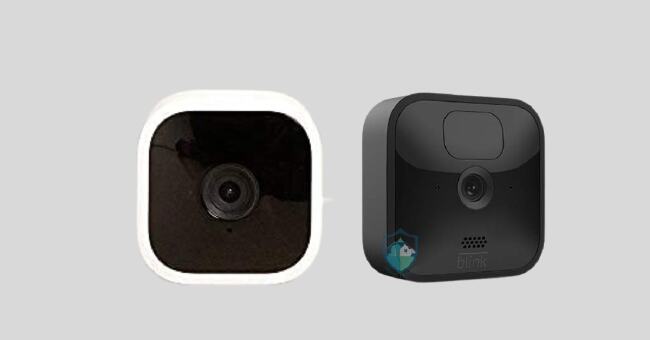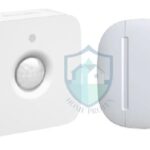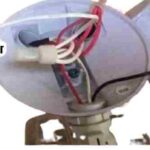Do you want to know why is the motion sensor not working on Blink camera? Yes, there are several possible reasons and solutions to try.
This was the frustrating question I kept asking myself every time I checked my phone notifications.
Despite having the motion zones set correctly, I wouldn’t get an alert when someone approached my door. The doorbell seemed useless if it wouldn’t detect visitors.
I had installed the Blink myself a few months ago and thought it worked flawlessly until the motion detection suddenly stopped working.
I will explain in this blog post the common causes and solutions I learned to get the motion sensor on my Blink doorbell working again.
By adjusting some settings and troubleshooting the issue step-by-step, I was able to fix the problem and have a fully functional video doorbell once again.
Common Causes of Motion Sensor Not Working On Blink Camera
Before I get into the solutions, it’s important to understand what causes the motion sensor on Blink doorbells to stop working properly. Knowing the possible reasons it fails can help narrow down what to check or fix.
Blink doorbells rely on a passive infrared (PIR) motion sensor to detect when someone approaches your door.
This sensor monitors for changes in infrared heat signatures and signals the doorbell camera to start recording when it detects motion.
There are several common culprits for why the PIR motion detection can fail:
Incorrect Motion Detection Settings
One of the most common reasons your Blink doorbell stops detecting motion is because the settings are not configured properly.
Within the Blink app you can configure the motion detection zone, sensitivity level, and cool down period. If these are set incorrectly, it can essentially disable motion alerts.
For example, if the motion detection zone is not covering the area someone would walk up to your door, their movement won’t trigger the sensor. Or if you set the sensitivity too low, the motion detector won’t pick up subtle heat signature changes.
A long cool down period between motion alerts can also result in missed notifications if multiple people approach during that time gap.
Faulty Motion Detection Hardware
In some cases, the issue stems from a hardware defect or failure with the motion sensor itself or the doorbell camera module.
The PIR sensor can malfunction and fail to register heat signature changes. Or connectivity problems might disrupt communication between the sensor and camera.
Defective units that slipped through quality control could exhibit motion detection issues right out of the box. More commonly though, components degrade over time leading to eventual failure.
If your Blink has been working fine for awhile but now has motion detection problems, it likely indicates a hardware defect or component wearing out.
WiFi Connectivity Problems
Since Blink doorbells operate wirelessly, any disruptions to the WiFi connection can interfere with motion detection.
An unstable WiFi signal, dead zones, or limited range away from the router can all impact performance. The doorbell may connect intermittently or bandwidth may be constrained.
Shared networks with lots of devices can also congest the connection, especially older 2.4GHz networks versus 5GHz.
Weak WiFi strength right at the doorbell’s installed location is one of the biggest connectivity issues.
Outdated Firmware
Buggy firmware on your Blink doorbell can also be the culprit behind motion detection failure. Firmware is the core software that runs on the device.
As Blink releases firmware updates, they fix bugs and improve performance. However, if your doorbell is running an old firmware version, it could contain a motion detection glitch that was resolved in newer versions.
Failing to keep the firmware updated is a common reason for technical issues to appear. An update may be necessary to patch a motion detection problem.
Extreme Temperatures
Finally, environmental factors like very cold or hot weather can disrupt the motion sensor. The PIR sensor has an optimal temperature operating range.
In frigid winter or hot summer weather, the extreme temps can interfere with detection. Heat signature readings become less reliable.
Thermal issues and overheating of the doorbell hardware itself can also develop in hot outdoor conditions, leading to potential failure.
Carefully inspecting your Blink doorbell settings, connectivity, hardware, firmware, and environment should reveal what is causing the motion detection issue.
Steps to Fix Non-Detecting Motion Sensors on Blink Doorbell
Once you’ve diagnosed the potential source of the problem, it’s time to try out some troubleshooting steps to get your Blink detecting motion again.
Adjust Motion Detection Settings in Blink App
The first thing to check is whether your motion detection settings need adjustment. Log into the Blink app and go to the settings for your doorbell.
Under Motion Settings, check the motion zones and make sure the detection area covers where people will be approaching your door. You want it angled and sized to create a zone 1-2 meters out.
Next, look at the motion sensitivity setting. If it’s too low, the motion sensor won’t pick up people walking up to your door. Turn it up to High if you find it’s missing visitors.
Also check the motion re-trigger time. This is the cool down period between motion alerts. If you have it set to 5 minutes, you won’t get notifications for each person coming during that time. Set it to the lowest time of 10 seconds.
Adjusting these parameters properly based on your doorbell’s field of view can instantly fix motion detection problems. The default settings may not work well for your specific installation.
Switch to 5GHz WiFi Band
If adjusting the Blink’s settings doesn’t resolve the issue, look into your WiFi connection. The ideal setup is connecting your Blink doorbell to a 5GHz network instead of the older 2.4GHz band.
The 5GHz channels have much better throughput and less interference from other devices. Switching to this band can clear up stability and range issues.
Make sure your wireless router broadcasts a 5GHz network in addition to 2.4GHz. Give the 5GHz network a different name like “YourNetwork_5G” to differentiate it.
Then go into your Blink app settings and have it connect to the 5GHz network. Stay close to the doorbell as you switch networks in case you need to reconnect it. This resolved constant disconnects for me.
Also check the WiFi signal strength directly at the doorbell’s installed location. Use a wireless scanning app on your smartphone to read the strength. Anything below -60 dBm will cause problems.
If the signal is poor there, you may need to move your router closer, add range extenders, or install external antennas to boost the coverage.
Update Blink Doorbell Firmware
Failing to keep your Blink firmware up to date can also lead to issues like motion detection failure.
Firmware updates add new features and fix bugs or performance problems. An outdated version is more likely to have glitches.
In the Blink app, go to Settings > Device Info and check the firmware version it is currently running. Then go to the app’s menu and select Upgrade Firmware. It will check for any new versions.
Follow the on-screen prompts to download the latest firmware and install it on your Blink doorbell. Stay nearby during the install process as the doorbell will reconnect to WiFi.
The process only takes a few minutes. Many times a firmware update can resolve motion detection problems caused by buggy code. So it’s worth trying early on.
Check Doorbell Placement and Angle
If your Blink doorbell suddenly stops detecting motion, also check whether anything about its physical placement has changed.
Make sure the doorbell is mounted at a height between 4-5 feet as recommended by Blink. This gives the motion sensor and camera the optimal angle.
Look to see if the camera angle provides a clear view of the approach pathway without obstructions. Trees or bushes growing in could be blocking the sensor’s field of view.
If the placement and angle look correct, try cleaning the motion sensor lens which could just be dirty. Use a microfiber cloth to gently wipe the sensor surface.
Subtle shifts in position from wind or other impacts can change the alignment. You may need to adjust the mounting angle again.
Contact Blink Support
If you’ve gone through all of the troubleshooting steps above – adjusting app settings, switching WiFi networks, updating firmware, checking placement – and the Blink doorbell still fails to detect motion, then the issue is likely a hardware defect.
At this point your best recourse is to directly contact Blink customer support. Explain the testing you did and the persistent motion detection failure.
Blink support can run diagnostics on your doorbell unit remotely to pinpoint any problems. If they determine the motion sensor module is defective, they will replace your doorbell for free under warranty.
For issues outside of the warranty period, you can purchase a replacement Blink doorbell module for $50 rather than a whole new unit. This is cost effective if just the sensor or a specific component has failed.
With Blink’s customer support, you should be able to resolve motion detection failures even when caused by hardware defects or failures. Just be sure to contact them sooner rather than later before your warranty expires.
Frequently Asked Questions
Why Doesn’t My Blink Doorbell Detect Motion?
The most common reasons your Blink doorbell stops detecting motion are incorrect motion settings, WiFi issues, outdated firmware, or hardware defects.
Check that your motion zones cover the approach area and sensitivity is set to high. Switch to a 5GHz WiFi network for better connectivity.
Update to the latest firmware to fix any bugs. If it still doesn’t detect motion, contact Blink support to replace defective hardware while under warranty.
How Do I Get Motion Detection To Work On My Blink Doorbell?
To get motion detection working on your Blink doorbell, first adjust the motion zones, sensitivity and re-trigger time in the app settings.
Make sure it’s connected to a strong 5GHz WiFi signal. Update the firmware. Physically inspect the positioning and angle to ensure the sensor’s view is clear.
Clean the motion sensor lens gently. If issues persist, Blink can help diagnose hardware problems still under warranty and send a replacement unit if needed.
Why Is My Blink Floodlight Not Detecting Motion?
Check the motion settings are configured properly in the Blink app for your floodlight cam. Adjust the zones and detection parameters.
Switch to a 5GHz WiFi band and make sure signal strength is strong at the floodlight location. Update firmware to latest version. Verify floodlight positioning allows a clear view of the detection zone.
Ambient light changes can also interfere with detection – avoid installation near other lights. Contact Blink if hardware failure is suspected.
How Do I Adjust My Motion Sensor On Blink?
Open the Blink app and go to your camera or doorbell’s Settings > Motion Settings. From here you can configure the motion detection zone by dragging the corners to cover the desired area. Adjust the zone’s shape and size so it extends out 1-2 meters from the sensor.
Increase the sensitivity if needed. Lower the re-trigger time to make alerts more frequent. Adjust these to improve motion detection on your Blink device.
What Are Optimal Settings For Motion Detection?
The best settings for motion detection are creating a zone 1-2 meters from the sensor, setting sensitivity to High, and using a re-trigger time of 10-30 seconds between alerts.
Position the motion zone to cover approach pathways at optimal angles. Have the doorbell or camera mounted at 4-5 feet high. Keep firmware updated. Connect to a strong 5GHz WiFi signal. Tweak settings as needed for your specific installation.
How Do I Update Firmware on My Blink Doorbell?
In the Blink app, go to the Settings menu > Device Info to check your current firmware version. Then go back and select Upgrade Firmware.
It will search for any new versions available and prompt you to install them. Follow the on-screen instructions as the firmware downloads and updates your Blink doorbell wirelessly.
Stay nearby as it will disconnect and reconnect. Firmware updates resolve bugs and improve motion detection.
What Distances and Angles Work Best For Detection?
Blink recommends mounting your camera or doorbell 4-5 feet high looking down at a slight angle. This allows for the motion sensor to detect activity optimally in zones extending 1-2 meters out.
Position it covering approach pathways head-on rather than at wider angles. Keep the motion detection zone free of obstructions like trees and bushes for best performance.
When Should I Contact Blink Support For Hardware Issues?
If you’ve adjusted settings, updated firmware, optimized WiFi connectivity, and checked placement, but the Blink is still not detecting motion, it likely has a hardware defect needing replacement under warranty.
Contact Blink’s customer support team and explain the troubleshooting steps you performed. They can diagnose problems and send you a new unit if needed while still under warranty.
Does The Blink Doorbell Sense Motion?
Yes, the key feature of the Blink video doorbell is its passive infrared motion sensor that detects when someone approaches your door.
It will trigger the camera to record a clip when motion is sensed in the configured detection zone.
Problems like incorrect zone setup, low sensitivity, WiFi issues, or hardware failure can cause the motion sensing to malfunction.
How Do I Reset My Blink Doorbell?
In the Blink app, go to Manage Devices > your doorbell > Settings > Factory Reset. This will reset your doorbell to default settings.
You’ll need to fully set it up again, including connecting to WiFi. A reset can clear any software glitches, so try this if troubleshooting other issues doesn’t resolve motion detection problems.
How Do You Get A Motion Detector To Work?
Check motion activated lights and cameras during the day to see if their detection zone covers the right area. Trigger the sensor and make adjustments if needed.
For intermittent issues, replace batteries in battery powered detectors. Clean dirt off exterior motion sensor lenses. Update motion device firmware.
Switch motion lights to auto dusk-dawn mode. Increase sensitivity on motion sensors to maximum setting.
Why Is My Motion Sensor Light Not Sensing?
Make sure the motion sensor lens is clean and free of dust, dirt, or cobwebs. Adjust the sensitivity and PIR heat detector settings to their maximum range.
The battery may need replacement if it’s older. Verify the light bulb works and fixture isn’t damaged.
Check motion is being detected by observing the light blinking rapidly when triggered. Extend coverage with multiple motion lights.
How Do I Update My Blink Firmware?
Open the Blink app and go to the menu > Settings > Device Info. Check the firmware version it’s currently running. Then go to Upgrade Firmware.
Follow the prompts to download and install the latest firmware version available for your Blink module.
Stay nearby as the device will disconnect and reconnect from WiFi during the update process which takes just a few minutes. Keeping firmware up to date fixes bugs and improves performance.
Why Is Blink Doorbell Blinking Red?
A solid red light on your Blink doorbell means the battery is low and needs recharging. Blinking red indicates it is not getting sufficient power.
Fully charge the battery using the included cable. Make sure the connectors are clean. The battery may need replacement if old.
Try a factory reset after charging. If it still blinks red, contact Blink support for a diagnosis.
Why Is My Blink Doorbell Camera Blinking Blue?
A blinking blue light on your Blink doorbell means it is actively connecting to the WiFi network. Solid blue indicates it’s successfully connected online.
Blinking blue that persists for more than 5 minutes typically means it’s having trouble linking to WiFi, so you’ll need to troubleshoot your network connection.
How Does Blink Doorbell Work?
The Blink video doorbell connects wirelessly to your WiFi network. It has a built-in passive infrared motion sensor that triggers the camera to start recording when it detects a heat signature in its zones.
It sends these motion detection video clips to the cloud and notifies your phone. The battery-powered design can be installed anywhere without wiring. Settings like motion zones are configured in the Blink app.
Conclusion
When your Blink doorbell stops detecting motion, it renders the security camera features useless.
As we covered, issues like incorrect motion settings, WiFi problems, firmware bugs, and hardware defects can cause the motion sensor to fail.
Adjusting the sensitivity and detection zone, updating firmware, and tweaking the doorbell’s positioning are key troubleshooting steps.
For hardware failures still under warranty, promptly contact Blink’s customer support to arrange a replacement.
With consistent motion detection, your Blink doorbell can once again alert you of every visitor approaching your door.




